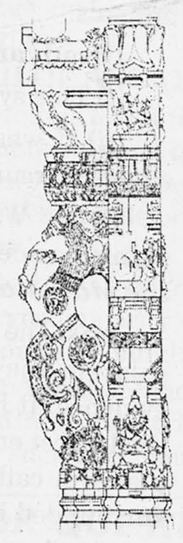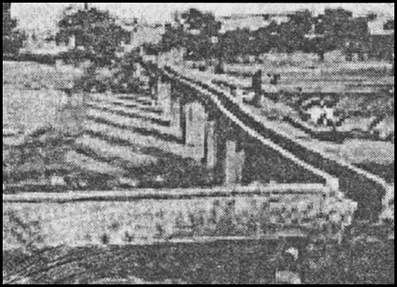
Fig. 7.33 is an illustration of another pillar from the Virupaksha temple. Do you notice any floral motifs? What are the animals shown? Why do you think they are depicted? Describe the human figures shown.
Given illustration of the pillar from the Virupaksha temple has pictures of plants bearing flowers and different animals-birds. Animals-birds include peacock, horse, duck etc. These pictures were probably carved on gateways to attract people. These pictures also express devotion, religiousness and love for art of patronage ruler.
Except this different animals and birds were associated with different gods and goddesses. That’s why they were also worshipped.
Human pictures include both respectively deities and their worshippers. A god is shown bearing malas and crown. He also has gadda in his hands. Probably he was a destroyer of Rakshashas. In another picture one devotee is shown near to ‘Shivlinga.’ His method of worship is also strange which is not applicable in any form.
What do you think were the advantages and disadvantages of enclosing agricultural land within the fortified area of the city?
A great fortification of Vijayanagara was accomplished in the fifteenth century. It also encircled the agricultural heartland and forests. This encirclement had the following advantages:
(i) It enclosed agricultural tracts, cultivated fields, gardens and forests.
(ii) It had an elaborate canal system which drew water from the Tungabhadra.
(iii) In the medieval period, sieges were laid to starve the defending armies into submission. These sieges lasted for many months or many years. So the rulers of Vijayanagara adopted an elaborate strategy to protect the agricultural belt and build large granaries.
(iv) This encirclement also saved crops from animals.
Disadvantages:
(i) This system was very expensive.
(ii) It was inconvenient to farmers during adverse circumstances.
How were the water requirements of Vijayanagara met?
The need of water in Vijayanagara was fulfilled from the natural basin formed by the river Tungabhadra which flowed in the northeastern direction. This was surrounded by stunning granite hills which formeu a girdle around the city. These hills were also the source of a large number of streams which flowed down to the river Tungabhadra.

So the rulers of Vijayanagara got built large embankments to store water. They also constricted reservoirs of varying sizes. They also made arrangements to store the rain water as this was the most arid zone of the peninsula. A very large tank was got built in the fifteenth century. It is now called Kamalapuram tank. The water of this tank served the following purposes:
(i) It irrigated the nearby fields.
(ii) It fulfilled the needs of the royal centre.
Besides the ruins of the Hiriya canal have also been found. This canal drew water from a dam across the Tungabhadra river. It irrigated the cultivated valley.
What do you think was the significance of the rituals associated with the Mahanavami dibba?
The Mahanavami Dibba was the king’s palace in Vijayanagara though there is no definite evidence. It had a distinctive structure. It had the largest enclosures. It had a very impressive platform called as “the audience hall.” It was surrounded by high double walls with a street running between them. There were many rituals associated with the Mahanavami dibba. Literally the Mahanavami meant the great ninth day of the ten-day Hindu festival during the autumn months of September and October. This period had Dussehra in the northern India, Durga Pooja in Bengal and Navaratri or Mahanavami in peninsular India. The rulers ofVijayanagara displayed their power, prestige and suzerainty on this occasion.
The ceremonies performed on this occasion included:
(i) Worship of the image.
(ii) Worship of the state horse.
(iii) The sacrifice of buffaloes and other animals.
(iv) The main attractions of this occasion were :
(a) Dances
(b) Wrestling matches.
(c) Processions of caparisoned horses, elephants, chariots and soldiers.
All these ceremonies had deep symbolic meanings. Most of them were presented before the king and his guests. On the last day of the festival, the king inspected his army as well as the armies of the nayakas. He also accepted rich gifts from the nayakas. There was a grand ceremony in an open field.
What have been the methods used to study the ruins of Hampi over the last two centuries? In what way do you think they would have complemented the information provided by the priests of the Virupaksha temple?
An engineer and antiquarian Colonel Colin Mackenzie brought the ruins of Hampi to light in 1800. He was an employee in East India Company. He prepared the first survey map of this site. His initial informations were based on the memories of priest of the Virupaksha temple and shrine of Pampadevi. From 1856 onwards, photographers started to record the pictures of monuments of this site which helped the scholars to study them. Dozens of inscriptions were collected from here and other temples of Hampi.
Historians collected information from these sources, accounts of foreign travellers and other literature written in Kannada,Telugu, Tamil and Sanskrit language so that history of the city could be reconstructed.
These functions complemented the information given by priests of Virupaksha temple.
